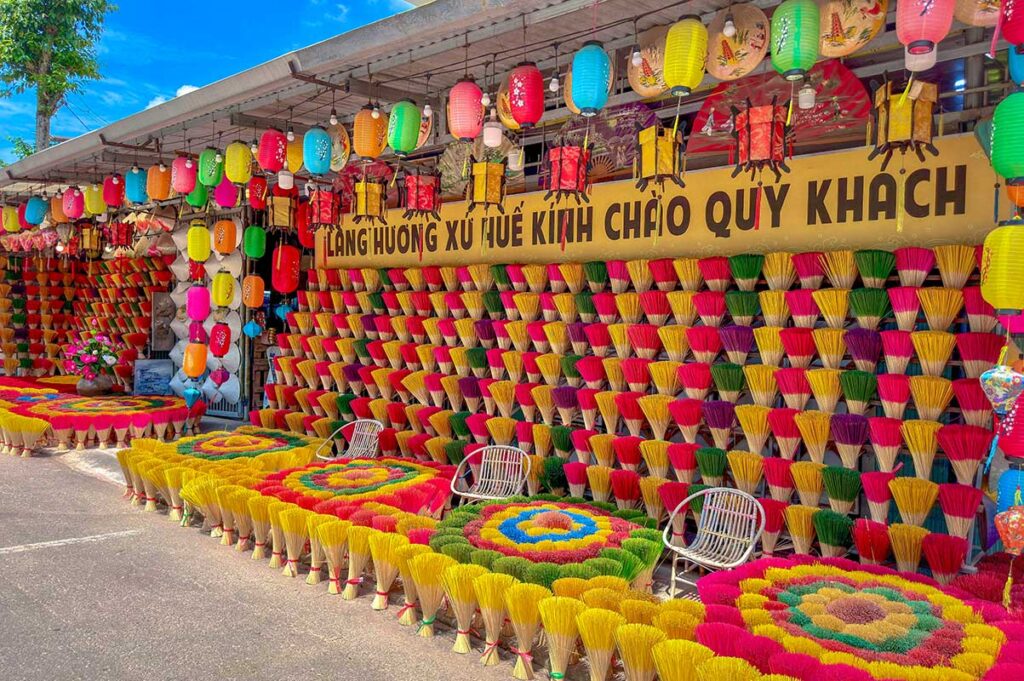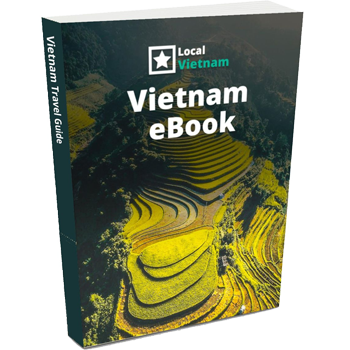What is Thuy Xuan Incense Village?
Thuy Xuan is Hue’s most famous incense-making village, known for its colorful roadside displays and long-standing tradition of craftsmanship. For centuries, local families here have produced incense for temples, home altars, and even the Nguyen royal court. Despite the name, it’s not a sprawling village—you’ll find a concentrated stretch of shops along Huyen Tran Cong Chua Street where the activity happens.
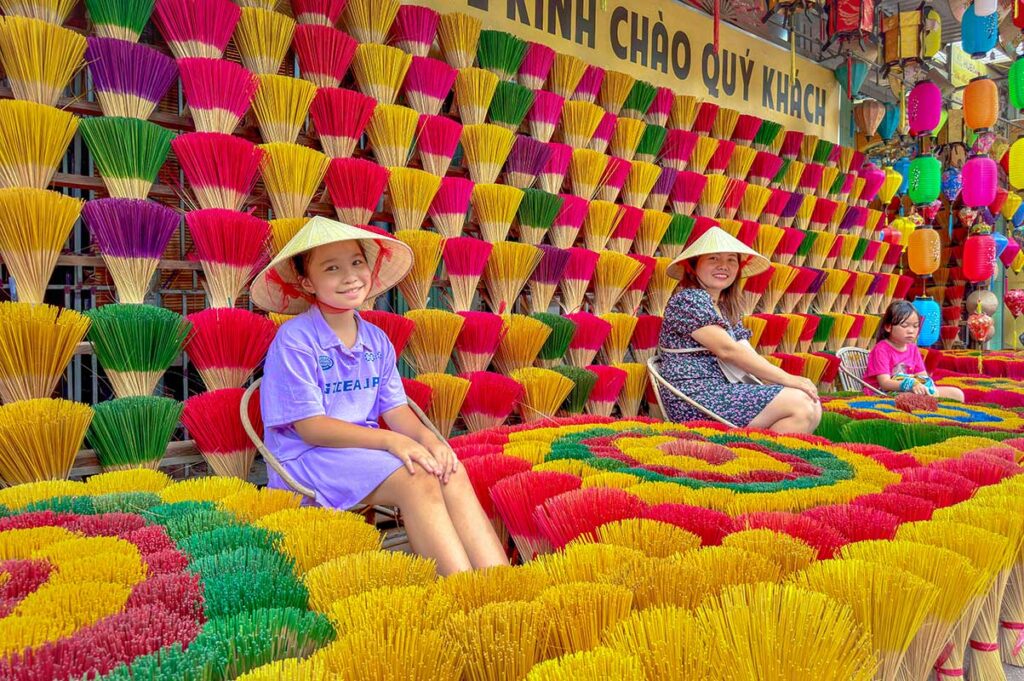

Most travelers visit for a quick cultural experience and striking photos rather than a full tour. Still, it offers a great glimpse into local life and a tradition that’s been preserved for generations.
History of Thuy Xuan
Origins and legacy
The incense-making tradition in Thuy Xuan dates back over 700 years to the Nguyen Dynasty. Back then, the village supplied incense to imperial temples, palaces, and officials throughout the royal capital. This heritage has been passed down through generations, and many families in the village still craft incense by hand today—using techniques that remain largely unchanged.
Role in Vietnamese spiritual life
Incense plays a central role in Vietnamese culture, especially in ancestor worship and spiritual rituals. It’s burned daily in homes, pagodas, and temples as a way to communicate with ancestors and the divine. In Thuy Xuan, incense is made from natural ingredients like cinnamon, agarwood, clove, and dried grapefruit peel—giving it a distinctive, earthy scent. Local artisans pride themselves on chemical-free production and incense that burns cleanly and evenly, which is essential for spiritual offerings.
What to see and do at the incense village in Hue
It’s not a full-scale attraction, but Thuy Xuan offers a fun and colorful stop packed with small experiences—perfect for travelers wanting to combine culture and photography in a short visit.
1. Watch the incense-making process
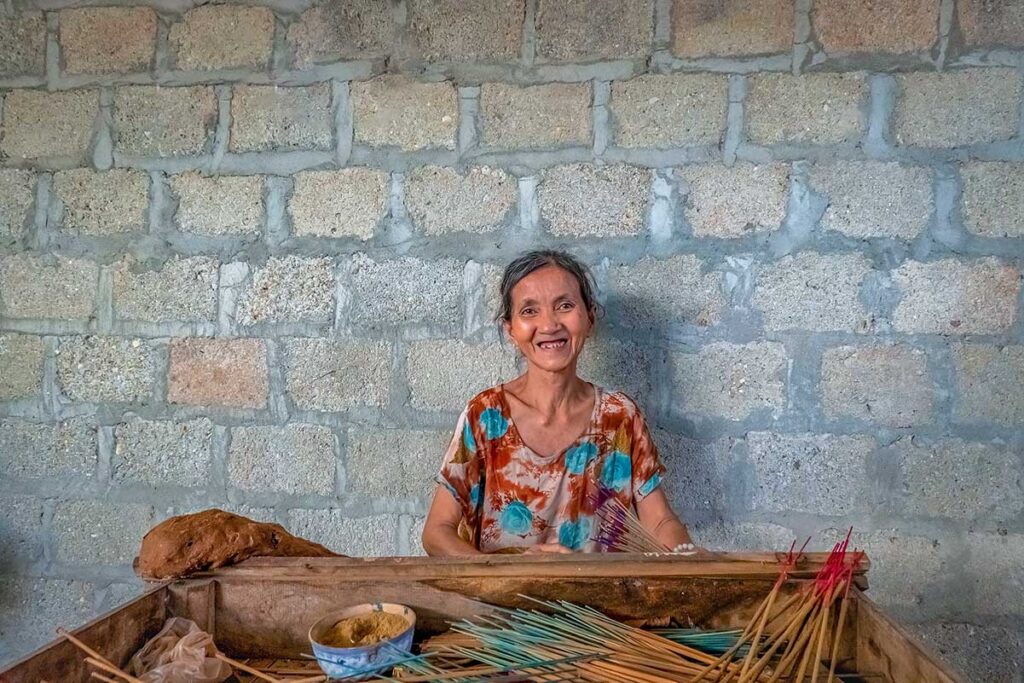
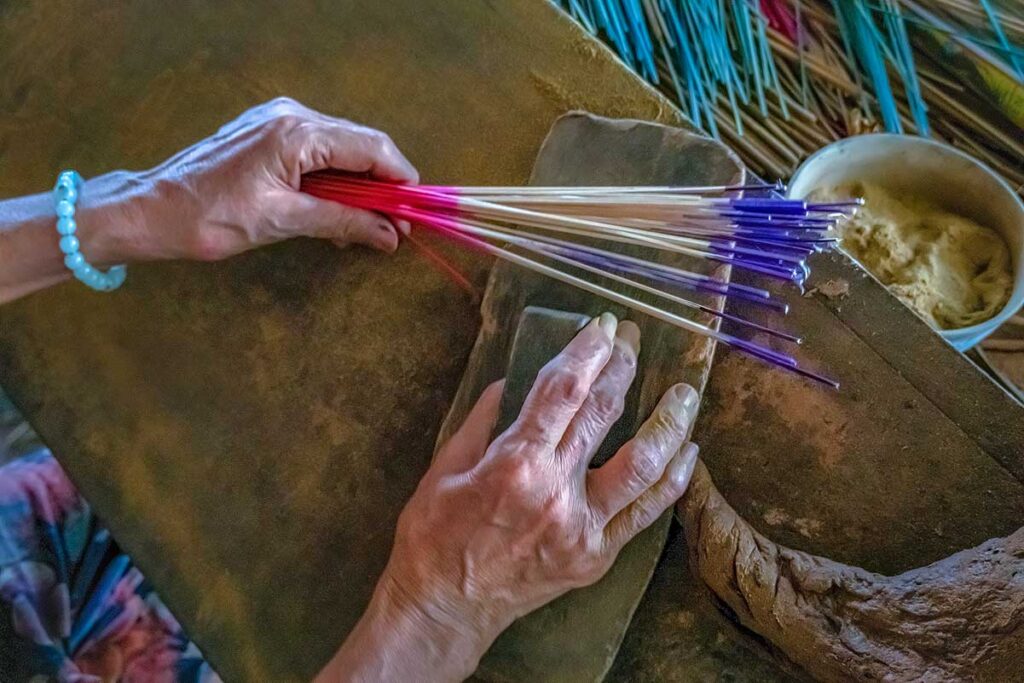
Walk past the shops and you’ll see artisans preparing bamboo sticks, mixing natural powders, and hand-rolling incense. It’s mostly done outdoors or in open-front workshops, so you can observe up close. Some shop owners may invite you to try a step or two—just ask respectfully, especially if it’s not too busy.
2. Take colorful photos
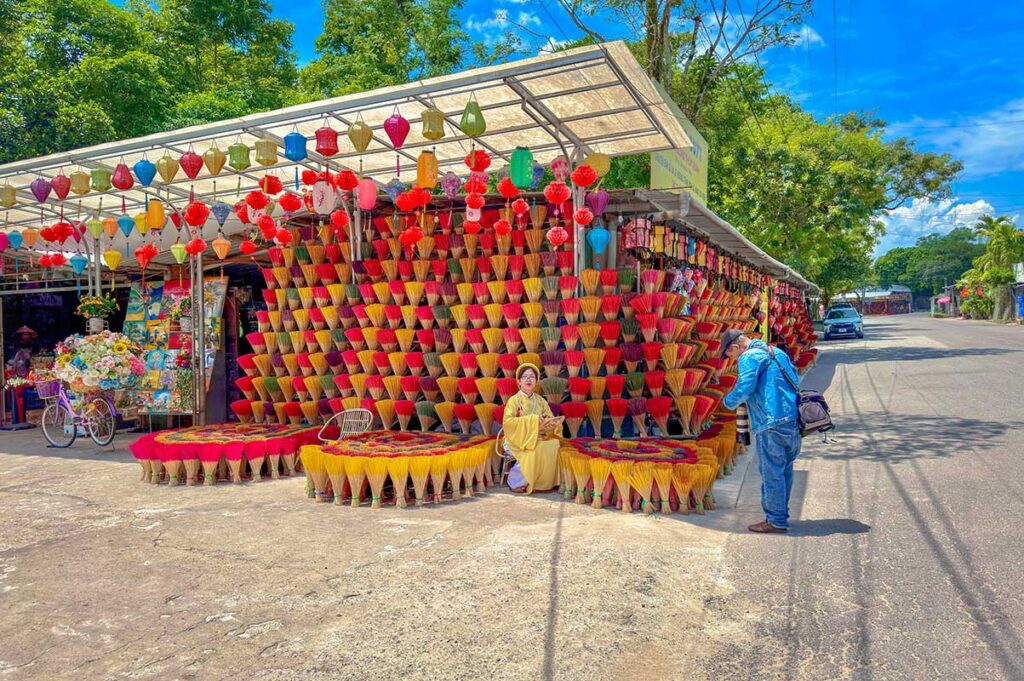
Brightly colored incense sticks—fanned out in rainbow displays—line the shopfronts, creating one of Hue’s most photogenic spots. Some of these are real drying racks, while others are arranged specifically for photos. Early morning and late afternoon provide the best light and fewer shadows. You can pose in front of the displays, but avoid blocking working areas.
3. Buy local incense and souvenirs
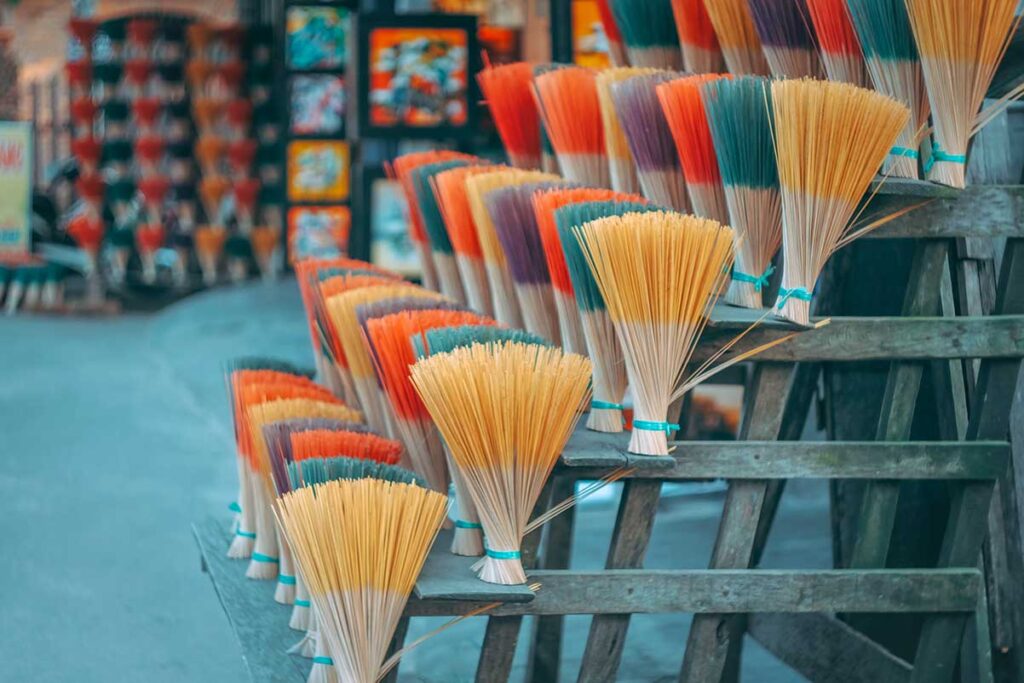
Most shops sell incense in a variety of natural scents: cinnamon, lemongrass, sandalwood, agarwood. Prices range from 40,000 to 200,000 VND per bundle, depending on the material. Higher-end agarwood can be around 300,000–600,000 VND. You’ll also find herbal oils, small brocade items, and handmade fans—nice to bring home or give as gifts. Even if you’re mainly visiting for photos, buying something small supports the local families.
4. Experience making incense
Some vendors offer simple, informal incense-making experiences. It’s not a formal workshop, but if you show interest, they may walk you through the basics—rolling incense or arranging the sticks for drying. It’s a short but nice way to connect with the craft and the people behind it.
Best time to visit
March to August is the ideal time to visit Thuy Xuan Incense Village. This is Hue’s dry season, when artisans display colorful incense sticks outside to dry—perfect for photography and seeing the village at its most vibrant.
Visit in the morning or late afternoon for cooler temperatures and softer light. Midday sun can be harsh, especially in summer.
Try to avoid the rainy season from October to January—you’ll see fewer displays, and incense production often moves indoors.
Bonus tip: Visit during Tet (Vietnamese Lunar New Year) or the Hue Festival if your timing allows. The village becomes much livelier, with traditional decorations, more activity, and a festive atmosphere.
Visiting information
Location
Thuy Xuan Incense Village is located along Huyen Tran Cong Chua Street, about 5–7 km southwest of central Hue. It’s conveniently placed near other major sites like Tu Duc Tomb and Vong Canh Hill, making it an easy cultural stop on the way to or from the tombs.
Opening hours
There are no official opening hours, but most incense shops open daily between 8:00 AM and 5:00 PM. Some might open earlier or stay open a bit later depending on the season and tourist traffic.
Entrance fee
There is no entrance fee to visit the village. However, if you take time for photos, ask questions, or enjoy demonstrations, it’s appreciated if you support the artisans by buying a small item.
How much time to visit
You’ll need about 20–30 minutes for a typical visit. If you decide to try incense making or browse the shops for souvenirs, plan for up to an hour.
How to get there
It’s easy to reach Thuy Xuan Incense Village, especially if you’re already heading to nearby sites like Tu Duc’s Tomb. The village is located along a scenic road southwest of Hue’s city center.
Taxi or Grab
The fastest and easiest option from most hotels in central Hue.
- Travel time: ~15 minutes
- Cost: 40,000–60,000 VND for a car
- GrabBike is also available and cheaper for solo travelers.
Motorbike
A convenient way to explore if you plan to visit multiple tombs or Vong Canh Hill.
- Make sure you have experience riding and a valid license with IDP.
- Roads are relatively calm, especially compared to other Vietnamese cities.
Bicycle
Great for active travelers.
- The road is flat, quiet, and scenic.
- Some hotels offer free bicycles; rentals are also widely available.
- Hue is one of the more bike-friendly cities in Vietnam.
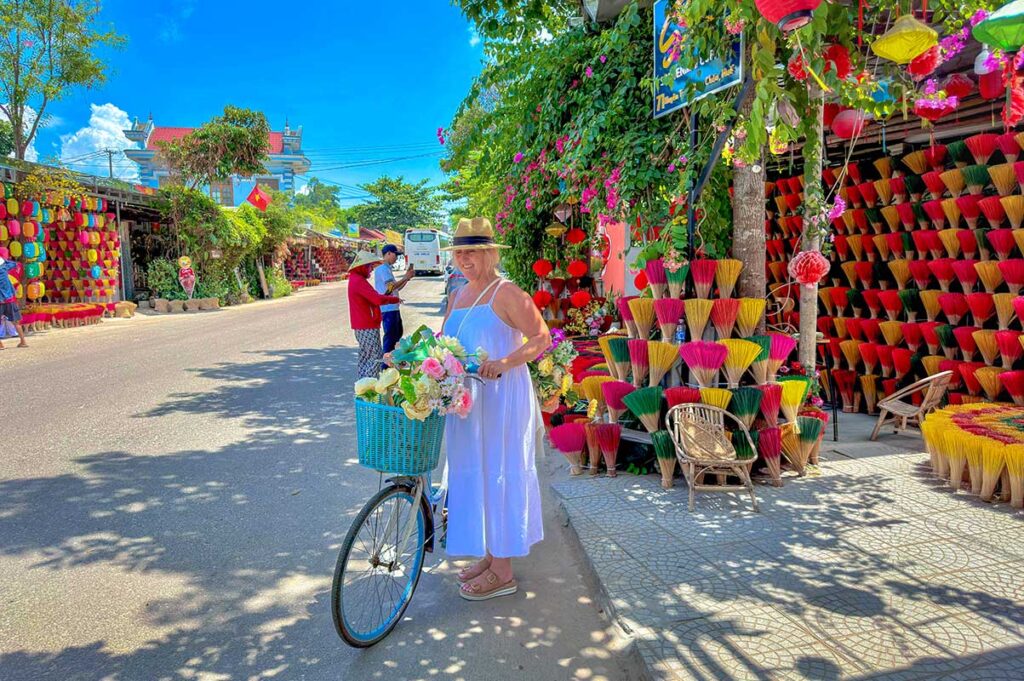
Tour
Included in many Hue day tours.
- Often combined with Tu Duc Tomb, Imperial City, Dong Ba Market, a dragon boat ride, and one other tomb.
- Quick photo and souvenir stop, but a good way to experience it without planning separately.
Travel tips for visiting the Incense Village in Hue
Thuy Xuan is a quick and colorful stop—not a full-day destination—so a few simple tips can help you make the most of it.
Photography etiquette
The displays are inviting, but be respectful. Ask before taking close-up photos of artisans, especially if they’re working or with family.
Expect some crowds
During high season or holidays, the village can get busy with tour groups and photo-seekers. Early morning or late afternoon is best for a quieter experience (and better light).
Support local vendors
If you spend time taking photos or talking to artisans, consider buying a small incense bundle or souvenir. Most shops are family-run and rely on visitor support.
Avoid unrealistic expectations
Despite its name, Thuy Xuan is more of a colorful street with incense shops than a sprawling village. Great for a 20–30-minute cultural stop, not a full tour.
Combine with other nearby sights
It makes the most sense as part of a half-day trip to the tombs and countryside:
- Tu Duc Tomb (~1 km / 3 min): One of Hue’s most visited royal tombs, known for its poetic layout and tranquil setting.
- Vong Canh Hill (~1 km / 2 min): A peaceful viewpoint over the Perfume River, great for sunset or a quiet break.
- Tu Hieu Pagoda (~1.4 km / 3 min): A working monastery with beautiful grounds and deep historical ties to Hue’s Buddhist heritage.
- Khai Dinh Tomb (~7.3 km / 12 min): Unique tomb blending Vietnamese and European architecture—dramatic and highly photogenic.
Is it worth visiting Thuy Xuan Village?
Yes—if you’re already visiting the nearby tombs or enjoy local culture, crafts, or photography. The colorful incense displays and friendly atmosphere make it a fun, low-effort stop.
No—if you’re expecting a full “village” experience or something immersive and large-scale. It’s more of a scenic roadside stretch with shops than a full cultural attraction.
That said, it’s a great way to break up visits to the tombs with something light, photogenic, and hands-on. Just go in with the right expectations—small, but charming.
